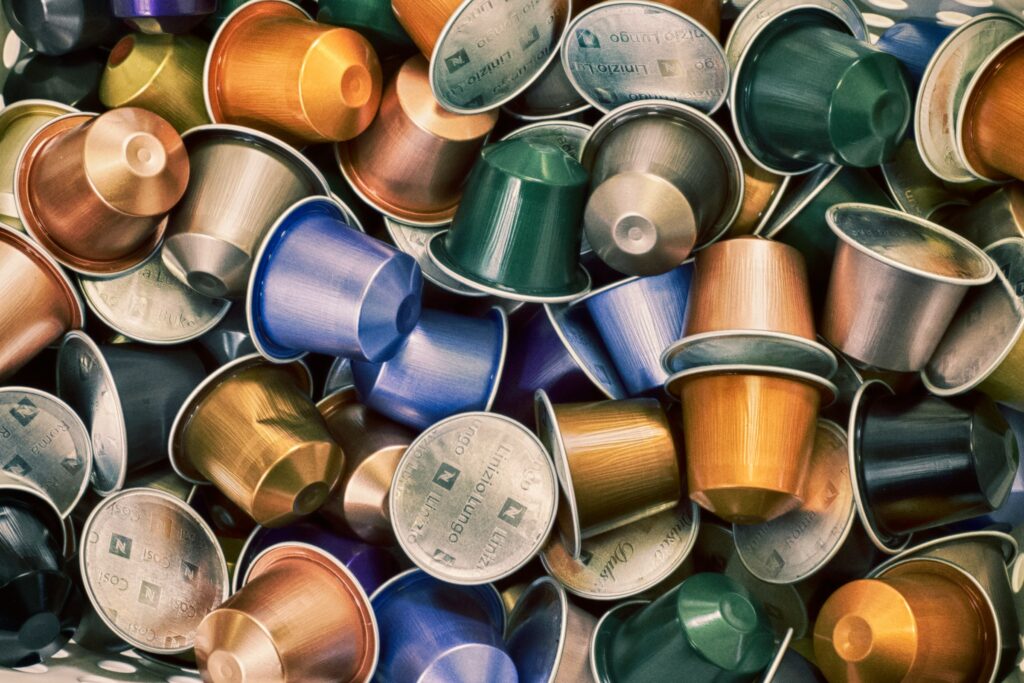Coffee is more than a drink—it’s a daily ritual. But behind every cup lies a hidden cost: plastic lids, paper cups, and farming methods that strain the planet.
The good news? A few small tweaks in how you sip can cut waste and lighten your footprint.
In this post, we’ll explore practical, no-fuss ways to keep your coffee habit strong while keeping the Earth in mind.
The Environmental Impact of Coffee
Every cup of coffee comes with a story that stretches far beyond your kitchen counter.
From the energy-intensive farming methods that require water and fertilizers, to the long shipping routes that move beans across oceans, coffee carries a hefty carbon footprint before it even reaches your mug.
Add in the brewing stage—machines using electricity, kettles boiling water—and suddenly your morning pick-me-up looks more like a small environmental tab than a harmless ritual.
Then there’s the waste problem: billions of paper cups lined with plastic, stirrers that get tossed after two seconds of use, single-serve pods that pile up in landfills, and packaging that often can’t be recycled.
It’s a lot, but here’s the good news: tiny changes really do stack up. Swapping a disposable cup for a reusable one once a day keeps hundreds of cups out of the trash each year.
Choosing bulk beans instead of individually wrapped pods saves heaps of packaging.
Think of it like compound interest—the little eco-friendly choices you make daily snowball into a big impact over time.
Choose Sustainable Coffee Beans
Choosing the right beans is one of the easiest ways to turn your daily brew into a force for good.
Labels like Fair Trade, Rainforest Alliance, or organic aren’t just fancy stickers because they signal that farmers are being paid fairly, harmful chemicals are limited, and forests aren’t being stripped bare just to grow coffee.
Supporting local roasters who take the time to source responsibly adds another layer of impact because your dollars stay in the community while encouraging sustainable farming practices abroad.
And let’s not forget shade-grown coffee, which is a quiet hero for the environment; instead of clearing land, farmers let trees provide natural cover, protecting bird habitats, enriching soil, and keeping ecosystems balanced.
Every bag you buy becomes a vote, and when you choose beans grown with people and the planet in mind, you’re making your morning ritual part of a much bigger story.
Reduce Single-Use Waste
One of the fastest ways to sip more sustainably is to cut down on the mountain of single-use waste that comes with coffee on the go.
Those paper cups lined with plastic may look harmless, but most can’t be recycled and end up clogging landfills.
A reusable travel mug solves that problem instantly, and as a bonus, many cafés even knock a little off your bill when you bring your own.
The same goes for straws and spoons: instead of grabbing the flimsy plastic versions that break halfway through stirring, toss a metal or bamboo set in your bag, and you’ll be covered anywhere.
And when you can, skip the extras altogether—do you really need that plastic lid for a drink you’re sipping right away, or the stirrer when a quick swirl of your reusable spoon does the job?
It’s these small swaps, repeated day after day, that turn your coffee habit into something a little kinder to the planet.
Rethink Coffee Pods and Filters
Single-serve coffee pods and paper filters might be convenient, but they leave behind a trail of waste that’s anything but small.
Plastic pods pile up in landfills by the billions, and most paper filters are bleached or treated, which means they don’t break down as cleanly as you’d hope.
Luckily, the fix is simple: eco-friendly alternatives are everywhere.
Compostable pods break down naturally, refillable pods let you enjoy your favorite grounds without tossing plastic, and reusable filters made of metal mesh or cloth give you a clean cup without the guilt.
If you want to go even further, skip pods and filters altogether with brewing methods like the French press, pour-over, or AeroPress, which are simple to use, produce less waste, and often taste better too.
Brew Smarter at Home
Brewing smarter at home is all about cutting waste without cutting flavor.
Instead of brewing cup after cup and pouring half of it down the sink, try making coffee in small batches you know you’ll actually finish, or brew a bigger pot and store the extra in the fridge for later.
Energy use adds up too, so lean on appliances that are designed to be efficient, or skip the plug altogether with manual methods like a French press or pour-over that deliver bold flavor without burning electricity.
Cold brew is another easy win: it’s smooth, refreshing, and made by letting grounds steep in cool water overnight, which means no boiling water, no machines humming away, and no wasted energy.
Compost and Repurpose Coffee Grounds
Don’t toss those used coffee grounds in the trash—they’re little powerhouses waiting for a second life.
When composted, they add nitrogen to soil, helping plants thrive while keeping organic waste out of landfills where it would otherwise release harmful gases.
If you don’t compost, grounds still have plenty of tricks up their sleeve: sprinkle them in the fridge as a natural deodorizer, mix them into a homemade scrub for soft skin, or use them as a gentle abrasive for scrubbing pots and pans without harsh chemicals.
Gardeners love them too because grounds can deter pests, enrich soil, and even help acid-loving plants like roses and blueberries flourish.
Think of it this way: your morning brew doesn’t have to end with the last sip—it can keep working long after, turning what most people see as waste into something genuinely useful!
Support Sustainable Cafés and Brands
Supporting sustainable cafés and brands is like casting a vote every time you buy a cup of coffee.
Eco-conscious cafés often make it easy to spot them, and they’ll encourage you to bring your own mug by offering discounts, run composting programs for grounds and food scraps, or proudly display where their beans come from.
Beyond cafés, more and more coffee brands are stepping up with biodegradable packaging, recyclable bags, and sourcing practices that put farmers and the environment first.
When you choose these businesses, you’re sending a clear message that sustainability matters, and that ripple spreads further than you might think: it rewards the good guys, pressures others to follow suit, and shows that customers care about more than just caffeine.
Embrace Plant-Based and Local Milk Options
Milk may seem like a small part of your coffee, but it carries a big environmental weight—dairy production creates a hefty carbon footprint through land use, water consumption, and methane emissions.
Plant-based options like oat, almond, soy, or coconut milk often come out greener, especially when you pick ones produced closer to home.
Local choices matter too, whether dairy or plant-based, because shorter travel means fewer emissions and fresher taste. Minimally processed options also keep additives low and nutrition higher.
Of course, taste is part of the equation—oat milk gives a creamy sweetness, almond adds a nutty edge, and coconut brings a subtle tropical note.
The trick is finding what works for your palate while keeping sustainability and health in mind.
At the end of the day, it’s not about giving up your favorite, but it’s about making mindful swaps that let you enjoy your latte without the environmental baggage.
Mindful Habits for Eco-Friendly Coffee Drinking
Sometimes the greenest coffee habits are the simplest ones. Buying beans in bulk cuts down on endless packaging and usually saves money too, especially if you bring your own container to refill.
Once you’ve got them, proper storage is key—keep beans in an airtight jar, away from light and heat, so they stay fresh instead of going stale and ending up wasted.
And perhaps the easiest habit of all is portion control: brew only what you know you’ll drink.
That half-full pot that gets poured down the sink every morning isn’t just wasted coffee, but it’s wasted water, energy, and money.
By paying attention to how much you really need, you avoid the guilt of tossing leftovers and make each cup count.
These small, mindful habits don’t take much effort, but they turn an ordinary coffee routine into a sustainable ritual that feels just as satisfying as the caffeine kick itself.
Final Words
Every sip matters more than you think. Small shifts, like a reusable mug, better beans, or composting grounds, add up to a big impact when multiplied by millions of coffee drinkers.
Remember, sustainability isn’t about being perfect; it’s about making steady progress.
So the next time you pour a cup, choose the option that gives both you and the planet a reason to smile!



